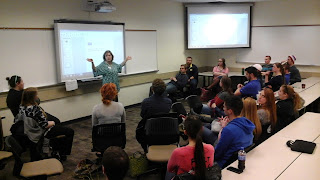Even for those of us who enjoy learning new technologies, there are times we resist adding a new tool to our repertoire. Such was my stance towards Interactive White Boards. It’s not that I didn’t understand the potential in using them, but in my own experience had only seen one used as a
 |
| Kim Kenward, GVSU, demonstrating IWBs to EDT370 students |
participant in a fairly traditional setting. However, the pre-service teachers in my GVSU educational technology course had been asking to know more. Last year our class met in a computer lab, so I arranged for a demo by GVSU’s instructional designer. Simple and straightforward, requiring little effort by me to change my own teaching. This year was different. All of our classes now meet in a room with either a Smart Board or Interactive Projector. This year, I needed to use it myself, and demonstrate best practices with it.
My debut was Friday, and thanks to the great support team at GVSU and my students, it was an enjoyable learning experience. Here are three tips I recommend for trying out a new technology in front of an audience:
1. Ask for help before you begin. I’m glad I covered all my bases and prevented unforeseen equipment failure sidelining my class. A few days before I planned to use the new (to me) technology, I attended a training and went directly to the room I’d be in to try out what I learned. Nothing worked. At all. Fortunately, I had enough time to schedule some one-on-one help. Turns out a cord was unplugged during a system upgrade and I would never have been able to fix it on my own as access required a key.
 2. Start small.
2. Start small. As tempting as it was to try all the new bells and whistles available using the cool interactives available at
Smart Exchange for my first use of the Epson Smart Projector, I’m glad I stuck to using favorites such as
Padlet and Google Slides. That way, I could focus on using the new interactive tools. When I hit the wrong button at times, I could easily find my way back to what I wanted to do.
3. Enlist your audience in failure prevention. Before beginning, I let my class know that this was my inaugural use of the interactive board. We talked ahead of time about the troubleshooting I’d done, my reasons for programs we’d be using, and that I was making my learning process explicit. I let them know they’d have time to try out the board and learn for themselves, discovering new features together. This “we’re in it together” approach meant when I forgot where to click, students were comfortable reminding me. When it was their turn, they were comfortable giving feedback to each other and experimented with it. They found interesting features and strategies, and asked good questions about other settings. We also had a great discussion about how when a teacher uses it, their back is still to the learners. However, when the teacher lets the students use it (which was the original intention of putting it in classrooms I believe) the teacher can easily observe the students’ learning progress.
 Bonus Tip: Use humor.
Bonus Tip: Use humor. Even with the best of preparation, things can still go wrong. In between back to back courses, I didn’t have time to retest a link. Of course, it didn’t work. We all had a good laugh though, as I had to troubleshoot in front of everyone.

 2. Start small. As tempting as it was to try all the new bells and whistles available using the cool interactives available at Smart Exchange for my first use of the Epson Smart Projector, I’m glad I stuck to using favorites such as Padlet and Google Slides. That way, I could focus on using the new interactive tools. When I hit the wrong button at times, I could easily find my way back to what I wanted to do.
2. Start small. As tempting as it was to try all the new bells and whistles available using the cool interactives available at Smart Exchange for my first use of the Epson Smart Projector, I’m glad I stuck to using favorites such as Padlet and Google Slides. That way, I could focus on using the new interactive tools. When I hit the wrong button at times, I could easily find my way back to what I wanted to do. Bonus Tip: Use humor. Even with the best of preparation, things can still go wrong. In between back to back courses, I didn’t have time to retest a link. Of course, it didn’t work. We all had a good laugh though, as I had to troubleshoot in front of everyone.
Bonus Tip: Use humor. Even with the best of preparation, things can still go wrong. In between back to back courses, I didn’t have time to retest a link. Of course, it didn’t work. We all had a good laugh though, as I had to troubleshoot in front of everyone.
